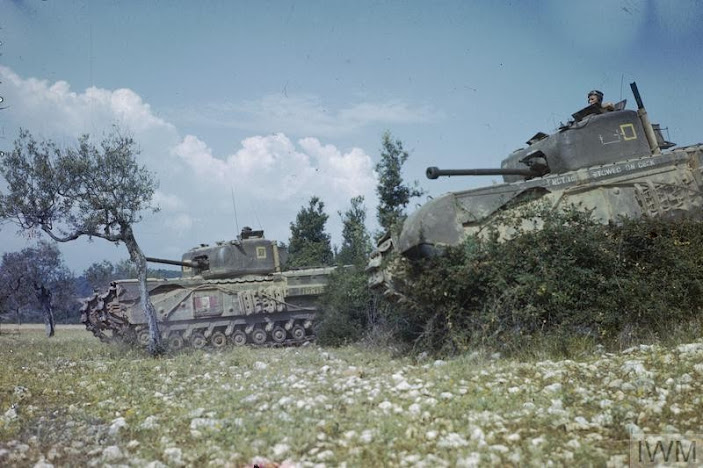Kiwis hunting Tigers. Sant' Andrea 30 July 1944.
History
" A
platoon from A Company, 23 Battalion, went along the road from Spedelleto to see
whether the enemy had withdrawn from Sant' Andrea, which was less than 600
yards from the company's foremost positions. The platoon crossed a small gully,
and as it topped the rise before reaching the village, ‘came under concentrated
fire at short range from several automatics and retired hurriedly and in some
confusion….’
Late in the afternoon enemy infantry attacked
again, but did not dislodge A Company. ‘My blokes shot about 12 counted Jerries
from the top windows and really had quite a good time,’ says Duncan. The
New Zealand casualties at Sant' Andrea that day were very few and included only
one killed. "
from The Official History of New Zealand in
the Second World War 1939-1945, Italy Volume II- Cassino to Trieste,
Historical Publication Branch, 1967, Wellington.
" A platoon from A Company, 23 Battalion, went along the road from Spedelleto to see whether the enemy had withdrawn from Sant' Andrea, which was less than 600 yards from the company's foremost positions. The platoon crossed a small gully, and as it topped the rise before reaching the village, ‘came under concentrated fire at short range from several automatics and retired hurriedly and in some confusion….’
Terrain
Forested ridges and tilled valleys filled with olive orchards and vineyards make for dense terrain off the roads which have been deliberately cratered by the Germans.
Deployment
The 22 battalion of 6 brigade, 2nd New Zealand Division are attacking toward San Andrea. This section of the Paula Line is held by 10th Parachute Division the arrival of a Tiger tank from 503 s.abt. the paratroops have counter attacked the advancing New Zealanders.The New Zealand forces set up within 20" of the south Western table corner. German Fallschirmjager forces are placed within 12" of the northern table edge. A 1d6 units are deployed in the first turn and each subsequent turn a further 1d6 units arrive at the respective table edge.
Special Rules
The road to San Andre has been demolished and is only passable by tracked vehicles.Victory
There are four objectives Sant Andrea, Spedatello, the gully south of Spedatello and the hill at Villa Mezei. The first to hold all objectives or exceed the BR rating wins.Maps
 |
| Map of the modern area from Google Maps |
After Action Report
Forces
forces from 2nd New Zealand DivisionForward Headquarters Lt Col Thomas & Captain Duncan (3 men) Officer, Artillery Spotter
1 platoon from A company 22 battalion
- Command Section and PIAT team 5 men Officer, Mortar Spotter
- 3 rifle sections 10 men with Bren
- Light mortar team 2" mortar
Sherman tanks A squadron 20 New Zealand Armoured battalion
- 2 Sherman III tanks
- 1 Sherman III tank Lt Colmore-Williams Officer, Mortar Spotter
1 M10 Tank destroyer
1 Vickers Heavy Machine gun team 3 men
1 Medium 3" mortar team 3 men
3 Officers 26 BR 320pts
forces from 10 Parachute Division and s.Abt508
1 Fallschirmjager platoon
- 1 Platoon command 6 men Officer, Mortar spotter.
- 3 Fallschirmjager squads 5 men with MG42
- 3 MG teams 3 men with MG42
- 1 Light mortar team 2 men with 50mm mortar
- 1 Medium mortar team 3 men with 80mm mortar
- 1 Panzershreck team 2 men with Panzershreck
1 Panzer IV G tank
1 Panzer V Tiger I tank
1 Officer 20BR 318pts
Historical forces should have 2 more platoons with medium mortars teams a side of infantry and the New Zealanders add 1 M10 and a timed 25 pounder stonk. The German support should have a panzershreck team and medium and light moratr per platoon.
AAR




Comments
Post a Comment